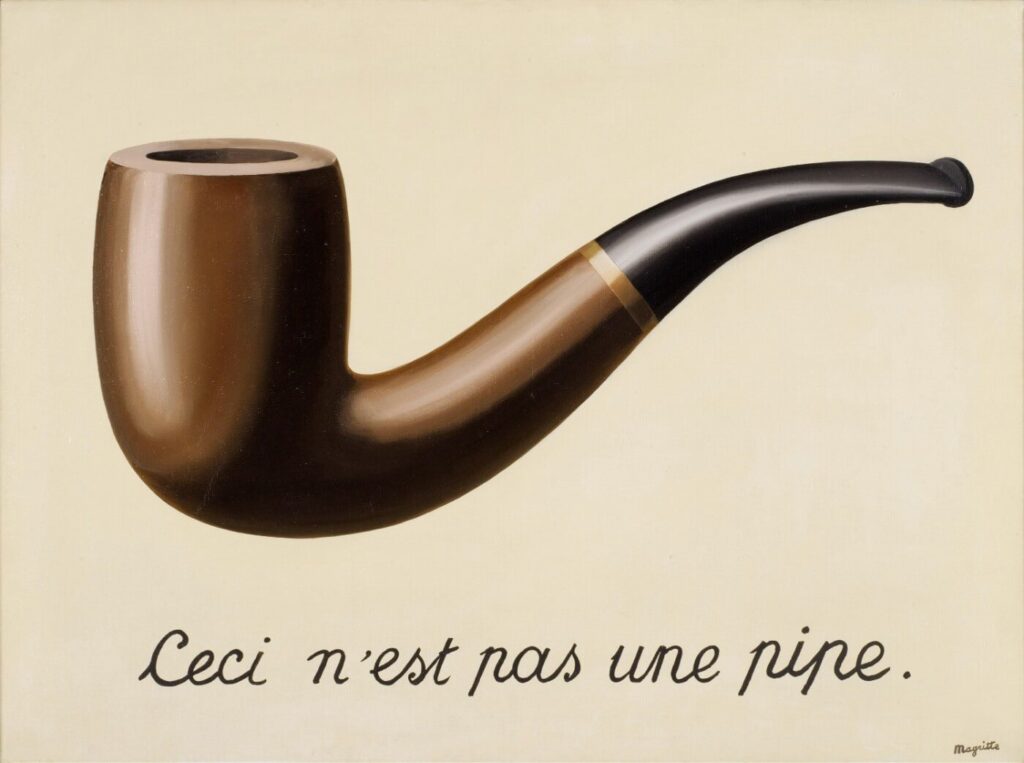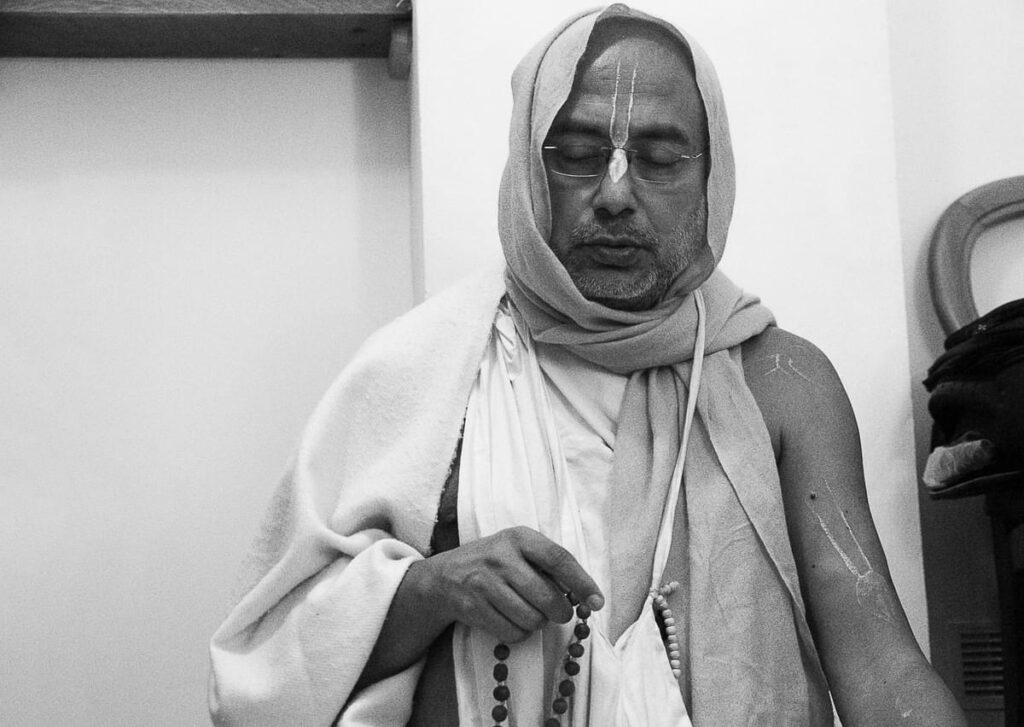We all mess up sometimes, even when we try our best. Still, no one wants to remain imperfect. We all have this thing inside us that wants to be perfect. If we didn’t, why would we ever try to get better? Our path to perfection, however, is often slow and hard. If it weren’t, we’d all be perfect right away. This inner conflict between our imperfect nature and our desire for growth creates space for a guide or guru.
A guru is a teacher. It can be someone who teaches us to play a musical instrument or a subject in school. However, the most essential guru in our lives is the one who guides us spiritually1.
A true guru is someone who has achieved spiritual perfection. He is the genuine representative of the Absolute. If someone claims to be a spiritual master but seeks only popularity and recognition, they are not a real guru.
Ultimately, the supreme guru is Krishna Bhagavan2, the personification of the Absolute Truth. He is the source of all expansions, all living entities, and the One who protects and supports everyone. In this Kali-yuga3, Krishna appeared as Chaitanya Mahaprabhu and taught us a simple method to achieve inner fulfillment and break free from the struggles of this world:
- Follow the path of self-realized souls (guru and Vaishnavas)
- Chant the Hare Krishna mahamantra.
The more sincerely and lovingly one chants the mahamantra, the stronger their connection with the Divine becomes. According to Chaitanya4 while chanting, one should be humbler than a blade of grass, more tolerant than a tree, and honor everyone without seeking honor for oneself. Those who chant the mahamantra in this mood are true representatives of the Truth and are true gurus.
Such a guru is honored as the Absolute Itself, as he is the most confidential servant of Bhagavan5. This is acknowledged in all revealed scriptures and followed by all learned transcendentalists. Therefore, Srila Raghunath Das Goswami advises to think of the guru as the topmost Vaishnava, who is very dear to Krishna Bhagavan6.
When we have such faith in a guru, Bhagavan will gradually guide us to His topmost representative. If we don’t find the right representative in this life, we will be reborn as humans in the next, and Bhagavan will give us a better guru.
Why Having a Guide Matters
Our vision is often clouded by the hope of happiness in material things, leading us to strive for physical pleasures such as delicious food and sensory experiences. These objects of sense gratification—sight, hearing, taste, smell, and touch—distract us from our true needs, which are spiritual.

However, a true guru can deliver us from all worldly distractions and struggles, guiding us to the eternally blissful and peaceful home of Sri Krishna and His pleasure potency, Srimati Radharani. Thus, a guru is weightier than the Himalayas, carrying immense significance in our spiritual progress. We should always strive to find such a guru and advance on our spiritual path.
To demonstrate the importance of the guru in our lives, Krishna Bhagavan, the supreme controller, took initiation from Bhaguri Rishi and learnt the sixty-four arts from Sandipani Muni. Through these actions, Krishna taught us that to progress on the spiritual path, we must accept a spiritual master and learn from him. Krishna’s dedication to serving His guru, Sandipani Muni, exemplifies this principle.
Once, Sandipani’s wife told Krishna, “Sons, I do not have enough firewood to cook today. Could you both please collect some firewood from the forest?” Krishna, Balaram, and Sudama went to the forest to collect firewood. On their way back, a massive storm started with lightning, thunderbolts, and heavy rain, preventing them from returning to the Sandipani’s ashram. Throughout the night, Krishna and Balaram kept the firewood on their heads and sat under a tree to protect it from getting wet.
Not seeing the boys return, Sandipani Muni became worried and searched for them. When he found them, he saw Krishna with the firewood on His head, shielding it from the night’s rain. Sandipani Muni thought, “Krishna suffers so much to save the firewood.” Sandipani Muni was deeply moved and pleased by Krishna’s level of determination.
Through this act, Krishna demonstrated the sincerity one must have in serving a guru. We should strive to follow in the footsteps of Krishna and His pure representatives. The closer we are connected to Krishna, the more divinity we will embody.
When Krishna completed His studies, He asked Sandipani Muni and his wife what kind of guru-dakshina7 they desired. Sandipani’s wife then said to Krishna, “You went to Mahakalpur and brought back to life the babies of a brahman who lost them at birth. Could You also bring back my son, Punar Datta?”
Upon hearing this request, Krishna went to Mahakalpur and brought Punar Datta to Sandipani’s ashram. In this way, Krishna fulfilled Sandipani’s wife’s desire. Through this act of service, Krishna shows us:
- Why is having a guide or guru essential?
- Why does serving those who guide us spiritually matter?
- The value of surrendering to them.
We should always remember this example and reflect on our dedication to serving our guru and Bhagavan.
Following a Guru
We should never think of ourselves as gurus. If we do, we are not true gurus. Srila Prabhupad Bhakti Siddhanta Saraswati Goswami Thakur clearly explained that anyone claiming to be a guru is unqualified. He once remarked that such a person should replace the first ‘u’ in the word “guru” with an ‘a,’ changing it to “garu” — a cow (sacred and worthy of respect, it is not more than animal).

A bona fide guru, whether initiating (diksha) or instructing (siksha), represents Krishna Bhagavan, the non-dual Absolute Truth. He has the power to save his disciple because he is closely connected to Krishna as His dearest assistant.
We cannot serve Krishna directly; therefore, He sends His representatives. Our focus should be on serving Krishna through these representatives. Srila Prabhupad emphasizes the importance of following a guru through instructive stories (Upakhyana Upadesha). For instance, he uses the example of Upamanyu and Ayodhaumya to illustrate how one should surrender to the guru.
To illustrate this principle, I want to give an example of my spiritual master, who dedicated his entire life to serving his guru, Srila Prabhupad Bhakti Siddhanta Saraswati Goswami Thakur.
Srila Prabhupad attracted all his followers to Krishna’s service but never saw them as his disciples. Instead, he called them bipod uddharan bandhav, meaning “friends who savior me from danger.”
My Gurudev tells us that Srila Prabhupad engaged him and everyone else so intensely that they had no time left to chant sixty-four rounds. Srila Prabhupad established a system requiring daily chanting of sixty-four rounds of Hare Krishna mahamantra. Devotees would approach him, explaining that after their duties, such as printing and distributing newspapers at railway stations and bus stands, they were exhausted and had little time left for chanting. They once asked if the number of rounds could be reduced. Srila Prabhupad responded firmly, “No excuses; everyone must make time to chant sixty-four rounds daily!”
Gurudev used to say that sometimes there would be no time to sleep. Srila Prabhupad made my Gurudev the editor of a daily newspaper called Dainik Nadia Prakash. This newspaper covered all spiritual matters and was at least six pages long.
Nowadays, everything is computerized, but in the past, everything was done by hand. There were no dictaphones. When Srila Prabhupad dictated, it was all written by hand and pressed manually, and then it would go for printing and be ready to distribute before mangal arati9. The devotees used to go around places to distribute these newspapers. Gurudev often said that Srila Prabhupad saved us and our youth by keeping us constantly engaged.
“Srila Prabhupad saved us and our youth by keeping us constantly engaged.”
Bhakti Pramod Puri
Once, Srila Prabhupad asked Hayagriva Prabhu10 what made him happy. Hayagriva Prabhu replied, “When you give me one service, and before I’ve even finished it, you give me another, it makes me very happy.” Prabhupad loved his answer.
I also heard from my spiritual master that when sannyasis11 returned from preaching, upon seeing them, Srila Prabhupad would ask, “What is your next program, and when are you going?” There was no question of, “Okay, go and rest.”
Srila Prabhupad never allowed anyone to relax in a temple. A temple is a place of service, like the office of Bhagavan and His representatives (guru and Vaishnavas). In a temple, everyone should always stay engaged in service.
If an employee thinks, “This office is great. It has air conditioning and is the perfect place for relaxing,” the boss is unlikely to keep him. Similarly, if we lack a service attitude in a temple and instead seek only comfort, we won’t be able to stay there. A temple is not a place for rest, and Srila Prabhupad conveyed this message by questioning his followers.
How to Develop a True Desire to Serve
In this age of deception and hypocrisy, the path to spiritual perfection lies in the sincere chanting of the Hare Krishna mahamantra. This practice awakens a genuine desire to serve and give with all our hearts.
The nature of the service is less important than the spirit in which it is performed; whatever service we receive from our guru and Vaishnavas should be carried out enthusiastically. Krishna, the ultimate guru, demonstrated this principle by collecting firewood on the order of His teacher, Sandipani Muni.
Chaitanya Mahaprabhu emphasized the chanting of the Hare Krishna mahamantra as the primary spiritual practice for this age12. Unlike previous ages, which prescribed meditation, fire sacrifices, or elaborate deity worship, our current age calls for a more straightforward yet profound practice.
This practice will help us develop a loving service mood toward Krishna, Srimati Radharani, and their pure devotees—our guru and Vaishnavas. That is why my Gurudev used to say that the only purpose of our discourses is to inspire everyone to chant the Hare Krishna mahamantra.

Today, I humbly pray to my Gurudev, as well as all the members of my lineage, from the bottom of my heart to please bestow all of your mercy on me and give me the strength to chant the Hare Krishna mahamantra without offense and engage me in your loving services.
Finally, I request all readers to reflect on your life and direct it toward serving Bhagavan at every step. It does not matter whether you are a householder or renounced; you can engage in the service of Bhagavan. Even if physical service is impossible, you can serve in your mind while chanting the Hare Krishna mahamantra. This is not an order but a humble request to you all.
Bhagavan has given us this human life to fix our minds on His service—that is spiritual perfection. So, I pray to my worshipful Gurudev, Vaishnavas, and Sri Sri Radha Krishna to please engage me in all Your loving services and deliver me from this miserable, mundane condition.
Yours in the service of Sri Chaitanya’s Mission,
Swami B.B. Bodhayan
We’d love to hear from you! If you have comments on this article or a tip for a future BSVT story, please email us at tips@bsvtrust.org. Your insights help shape our content!
footnotes /
- Why is that?
Spirituality is about our awareness and understanding of ourselves and the world. Growing spiritually means becoming a better person. This growth goes beyond learning facts; it changes how we think and feel, shaping our values and perceptions of life.
A spiritual guru helps us look within to discover our true selves and guides us through life’s challenges. They assist us in connecting with the Absolute Truth, bringing clarity to our lives. As a result, we begin to see things as they are, free from prejudices and illusions.
krishna rakshatu no jagat-traya guruh <…>
(Kulasekhar Alvar, Mukunda Mala Stotra, 3)- Kali-yuga
Kali-yuga is a time (yuga) of discord and degradation, ignorance and hypocrisy.
Kali comes from the word “kala,” meaning “black,” “leading to destruction”. This era began about 5 thousand years ago. It is the last era in the cycle of chatur-yuga (a sequence of four yugas: Satya, Treta, Dvapara, Kali).
The life of people in this era is described as follows: “In this iron age of Kali, the life of people is short. They are quarrelsome, lazy, under the influence of illusions, devoid of good qualities and constantly overcome with anxiety” (Srimad-Bhagavatam, 1.1.10).
- Chaitanya Mahaprabhu and His Teachings
trinad api sunicena taror iva sahisnuna
amanina manadena kirtaniya sada harihThis is the third verse of Chaitanya’s only poem, Shiksastaka. In this verse, Chaitanya discusses the attitude a genuine seeker of Truth should have.
Shiksastaka means “Instructions in Eight Verses.” This poem is important because it’s the only thing he left behind in writing. The main teachings of Gaudiya Vaishnavism were later developed by his key followers, known as the Vrindavan Goswamis.
- Why is that?
Vishvanath Cakravarti explains this in his poem, Gurvastakam. In the 7th verse, he writes:
sakshad-dharitvena samasta-sastrair
uktas tatha bhavyata eva sadbhih
kintu prabhor yah priya eva tasya
vande guroh sri-caranaravindamI worship the lotus feet of the spiritual master, who is inconceivably both different and non-different from the Supreme Personality of Godhead! All the scriptures glorify him as non-different from the Absolute, which is accepted by exalted saints. And yet, he is the dearest beloved servant of Bhagavan.
<…> mukunda-presthatve smara padam ajasram-nanu manah
(Manah-shiksha, 2)- Dakshina, or Guru-dakshina
It refers to the wealth or gifts offered by disciples to their spiritual teacher.
<…> krishna-bhakte krishnera guna sakali sancare
(Krishna Das Kaviraj, Chaitanya-charitamrita, Madhya, 22.75)- Mangala arati
An auspicious welcoming ceremony for the Krishna Bhagavan is carried out an hour and a half before sunrise, usually around 4 a.m.
- Hayagriva Prabhu
Hayagriva Prabhu was one of the dearest disciples of Srila Prabhupad. After taking the renounced order of life, he becomes known as Srila Bhakti Dayita Madhava Goswami Maharaj.
- Sannyasi
A renounced preacher who has taken sannyasa; a monk.
- The Best Spiritual Practice in the Kali-yuga
In the Chaitanya-charitamrita, Krishna Das Kaviraj describes a conversation between Prakasananda Sarasvati and Chaitanya Mahaprabhu.
Prakasananda asked Chaitanya why he was acting like a madman, jumping and dancing on the roads instead of studying Vedanta. Chaitanya replied that in this age of Kali, there is no spiritual practice other than the chanting of the holy name, which is the essence of all Vedic hymns. This, he said, is the main message of all the scriptures (Adi-lila, 7.74). To support his words, Chaitanya cited the following verse:
harer nama harer nama
harer namaiva kevalam
kalau nasty eva nasty eva
nasty eva gatir anyatha
(Brihan-Naradiya Purana, 38.126)